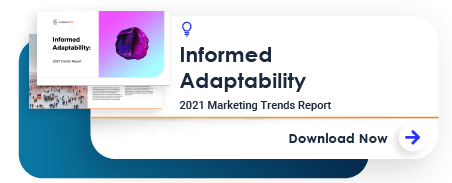We sort of know what’s coming, but do we know what steps to take now?
I find myself simultaneously fascinated and frustrated with every new news release related to post-cookie marketing and analytics. I, like most of you, have heard over and over about cookies going away, the new regulations, upcoming browser changes in 2022, what proposal Google is either making or rejecting, and the effects all of this will have on marketers being able to identify and address audiences. Right now, a mix of truths, predictions, and speculation is the current vibe. Multiply this by lack of awareness, the vast need for preparedness steps, the impending timeline, and the speed to which organizations must adapt. Well…it can be a bit confusing.
It’s fascinating because there is so much change and intrigue. It’s frustrating because we are aware of the end point (cookies going away and digital marketing and analytics will forever change), but the detailed steps we need to take are unknown. The road to the future is foggy for some. Perilous for others. Some don’t even know where it is!
I keep reminding myself of a simple statement made by our Director of Advertising, Steve Murphy that helped me guide digital transformation when I was at Allstate “The fundamentals of marketing never change and the execution is constantly changing.” For me, this means that the fundamentals of getting the right message/offer to the right people at the right time and place is something that we’ll always need to get right, and hopefully, as marketers we are somewhat good at. It’s just the execution (i.e., the data, the technology, the rules) that has to adapt. No small problem, to be sure.
Cookie-less marketing feels like a transformation moment (I am unsure if it’s a step forward or backward, TBH), but the design pillars seem to be familiar at least:
- Addressability and consent for when we know the consumer
- Contextual for when we don’t know the consumer, yet
- Navigating a partner’s capability to do both
- Building your own path because waiting is not worth the risk
Let’s look at each of these.
Addressability and consent
For companies who’ve been dependent on third-party cookies and third-party identity graphs, addressability and identity of unknown prospects is the largest thing that’s going to be diminished if not eliminated. Customers’ consent is now the issue: you will only have the identity of customers who have agreed to give you their data. The net-net to all of this means two simple truths:
- Addressability is still viable, but brands will need to have a direct one-way relationship between their data and where they can reach their customers. We can’t onboard and sync cookie audiences moving forward, but we can link identifiers between brands and publishers via means that will be addressed later.
- Everything else will need to be inferred, meaning that we’ll use the best available indicators and our best intuitions to align the right messages to the right audiences without being sure of identity at the individual level. This is how most marketing has been done both before and often during the emergence of the digital environment. It’s also called contextual marketing.
This is why we keep saying first-party data is your next strategy. Simply put, the more first-party data you can create and manage means that you will be able to identify more of your consumers in the ad tech ecosystem. The problem for many is that they haven’t been acquiring and building a robust first-party data asset and the needed tools, infrastructure and processes that it requires.
Contextual for when we don’t know the consumer, yet
While having everything else not addressable be inferred sounds sub-optimal, it really is a simple and powerful targeting approach that will be essential for many businesses going forward. Contextual targeting is an old technique of placing advertising within the venues or content that is relevant to your desired audience. Many of the digital advertising networks and publishers will be able to provide contextual information on audiences even though they won’t be able to provide individual identity information. Some will be able to provide contextual marketing data independent of the location of the ad being displayed.
If you have always done contextual and know where to reach your audience, then you will be well positioned come the post-cookie environment. For you, it’s time to start thinking about expanding these tactics versus remarketing or audience targeting in the short term.
If this is new space for you, then it’s time to start figuring it out, quickly. It’s a strategy game because you are not targeting based on behaviors, but where your customers might be on the web. Getting familiar with how this works for your brand will probably require trial and error. You’ll need to change how you test different strategies and your methods of measurement and attribution will need to change.
It’s important to remember that cookies are not dead yet, so you can use the tools of today to determine if targeting certain content sites actually drive consumers to your brand. You can run contextual marketing experiments alongside targeted ones for the next year to see what works so that you are not trying out contextual from a cold start come 2022. Figure this out using today’s tools and add it to your playbook. It might save you during the dark months when cookies fall off the map.
Navigating a partner’s capability to do both
This part is always complicated, but now ad-tech vendors are all creating their own solutions. Smart marketers will have to understand how their partners are modifying their approaches to utilize addressable advertising using your first-party data in the new environment, as well as using contextual techniques to tackle the audiences where identity and consent haven’t been acquired.
For example, Google is replacing identifiers with modeled cohorts (currently branded as FLoC, or Federated Learning of Cohorts) and closing DV360 off from the rest of the ecosystem. FLoC will tag groups of users within Google’s universe with their similar interests and other indicators of behaviors. You’ll be able to market to users of similar, known interests but not to specific individuals. For example, if a customer is tagged as part of the cohort who is interested in motorcycles, ads can be targeted towards that customer about motorcycles, even if they aren’t browsing anything specifically about motorcycles at the moment.
The Trade Desk’s Unified ID is a proposal for a single ID tag for customers across all ad platforms to inject identity linkages (e.g., a brand’s first-party data with publisher first-party data) into the bid stream, allowing for targeting as precise as the third-party cookie but not revealing any private data about users. Google has, as of this writing, rejected this proposal. There’s a possibility that marketers will have to use different methodologies across different ad network for targeting and attribution.
Other vendors and platform providers are still looking to create addressable solutions in the post-cookie era. Private identity graphs like Merkle’s Merkury, Neustar’s Fabrick and LiveRamp’s Safe Haven all have their own ID connections for brands to sync and target potential customers. Some publishers are building their own first-party data marketplaces to offer brands addressable options when their readers are authenticated. Some may form industry groups or consortiums to make their networks and value propositions more valuable. Demand-side platforms are emerging to aggregate different ad networks and configurations into single interfaces for marketers.
It looks like brand marketers will have to create a unique relationship with one or many of these partners as they pursue the identity side of the equation. This is certainly not new because we are always looking for the best inventory sources, but now the measure of inventory will be “how many matching IDs you have to my first-party data” versus “how many IDs can you reach.”
In most of these scenarios, and regardless of how these solutions emerge/converge in the future, the value they provide will be largely dependent on the brand bringing their own first-party data to the relationship. Brands without their own data won’t be able to do nearly as much in terms of really targeted advertising.
Building your path
Many, perhaps most, of the changes you will need to undertake will be within your own organization. There is not a singular solution to purchase here that will guide your company through this upcoming change. The entire drive to develop robust first-party data may drastically change your data collection and consent-gathering processes on your own owned channels (e.g., your store, your eCommerce site, your mobile app). Your organization will also likely need new tools, new data infrastructure, new processes, new data governance, probably some new skills/people and many other new capabilities to support the first-party data. There will likely be the assignment of new responsibilities and accountabilities among leadership. The path ahead will require change management and planning from within your four walls. You may need to conduct a needs assessment, create a comprehensive first-party data strategy, and develop a transformational roadmap that outline the step-by-step approach of how the organization needs to evolve. If you feel that this topic is not getting enough attention within your organization, you are not alone.
Think of it this way: if Cookies 100% depreciated tomorrow, and you were told the only way to target was by using your first-party data as the only way to reach consumers, do you think you were ready to do this and be happy with the results? If the answer is no, then you have some important decisions to make and some serious work to do. The good news is that you have a little time to learn and transform and even test a bit using the current environment. But you absolutely don’t want to be caught helpless when the changes do take place. It’s not just your advertising that will stall, it’s your marketing performance, your sales, your revenue, and your profits. It’s time to act and it might be later than you think.
Author

John is Vice President of Digital Transformation at Cardinal Path. He has 20+ years experience in identifying and implementing solutions that transform organizations. He’s passionate about helping brands build a long-term activation strategy that will help unify their customer data, targeting, technology and insights.
View all posts















